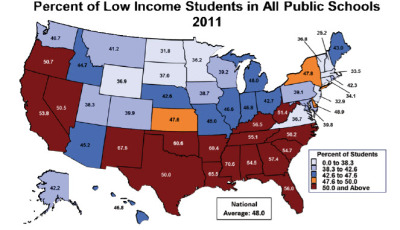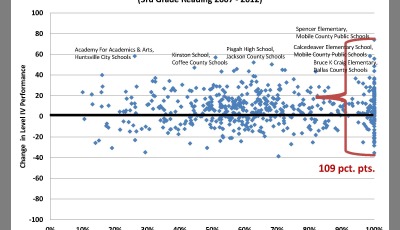Student Data for Alabama’s School Districts for the Past 11 Years. On a Map.
 Collecting information, a.k.a. data points, and sharing in a way that regular folks can not only understand, but also use the information, is central to the Alabama School Connection’s mission.
Collecting information, a.k.a. data points, and sharing in a way that regular folks can not only understand, but also use the information, is central to the Alabama School Connection’s mission.
While the Alabama State Department of Education does provide a lot of useful information, it’s not always in a format that’s easy-to-use.
With that in mind, a simple piece of information that folks might like to know is what demographic trends, if any, have there been in student enrollment in their school district.
[It’s even more helpful by school, but that’s a whole ‘nother gyration of data cleaning and crunching.]
Another piece of useful information might be what has happened to the percentage of students eligible for free or reduced-price meals over time. That percentage is often used as a proxy for the rate of poverty, though that’s getting a bit convoluted with the rise of community eligibility programs (where all students in a school or district are eligible for free meals due to the majority of students being eligible for free meals).
Why is this information important? Who needs to know?
Simply put, all of us.
Particularly those working in our schools.
In this article, posted on Counseling Today, school counselors shared the importance of knowing who a school’s students are to better understand the school’s community and culture, “what the needs are and how to meet those needs”, according to Lynn Linde, director of clinical experiences in the school counseling program at Loyola University Maryland, and chair of the American Counseling Association’s (ACA) 2013 School Counseling Task Force.
“As educators, we need to be adapting,” says Carlos Hipolito-Delgado, president of the Association for Multicultural Counseling and Development, a division of ACA. “We need to understand the kids that are coming in the [school’s] door and provide an experience that is relevant to their life and their culture. Unfortunately, I don’t think there are too many schools that are willing to engage in that work. Unfortunately, we push it off onto the students and force them to adapt.”
Rather than provide a full analysis of what the full data set reveals, here are a few interesting facts:
In the 2004-2005 school year, there were 130 school districts, of which 90 were majority White, and 39 were majority Black. In six districts, 100% of students were Black. In one district, 100% of students were White. In the entire state, 2.35% of the 729,128 students were Hispanic.
In the 2014-2015 school year, there were 136 school districts, of which 91 were majority White, and 35 were majority Black. In five districts, 100% of students were Black. There were no districts with 100% of the population being White. In the entire state, 6.1% of the 731,016 students were Hispanic.
Here, on a map, are the student enrollment demographics for eleven years, beginning with the 2004-2005 school year through the 2014-2015 school year. 2015-2016 enrollment figures are not yet available. Note that Pelham City Schools, which began operating in the 2014-2015 school year, are not reflected on the map as the shapefiles (that are used in mapping applications) do not yet reflect their existence. Those figures will be included in the accompanying spreadsheets (see “Get the Data” below).
This data visualization shows statewide totals of students by race and ethnicity.
Here’s a look at the percentage of students eligible for free or reduced-price meals by district during the same 11-year time period.
What do you see? What are the implications of these trends for your community’s children? For your neighborhood schools? For your community’s mission to educate the children in your community?
Get the Data
The source of the data is the Alabama State Department of Education Enrollment Reports portal. The data can only be viewed one year at a time. I aggregated the data for the 11-year period indicated and here are the links to those spreadsheets:
Student Eligibility for Free or Reduced-Price Meals by School District – 2004-2005 through 2014-2015
Student Demographic Enrollment Information by School District – 2004-2005 through 2014-2015





